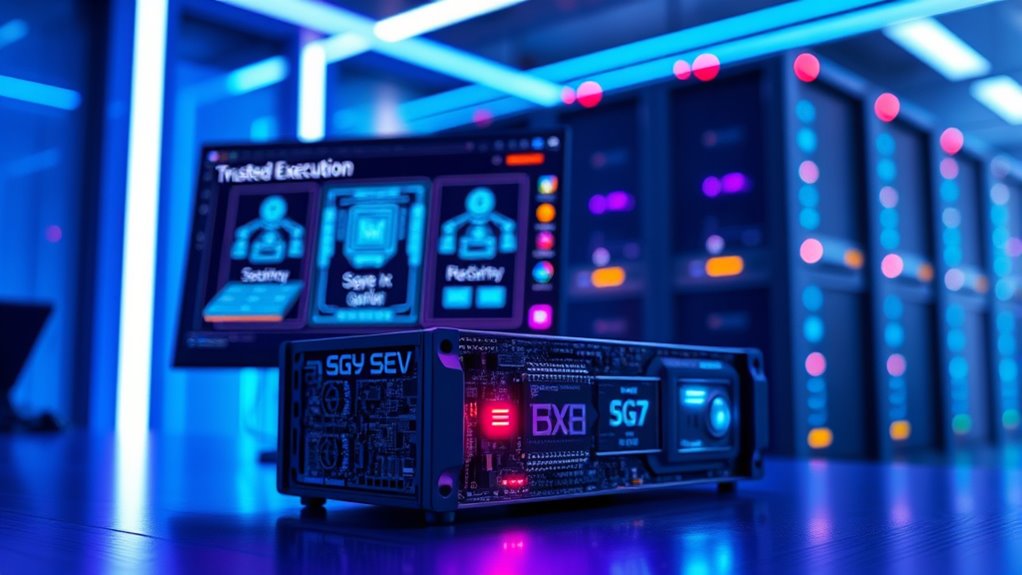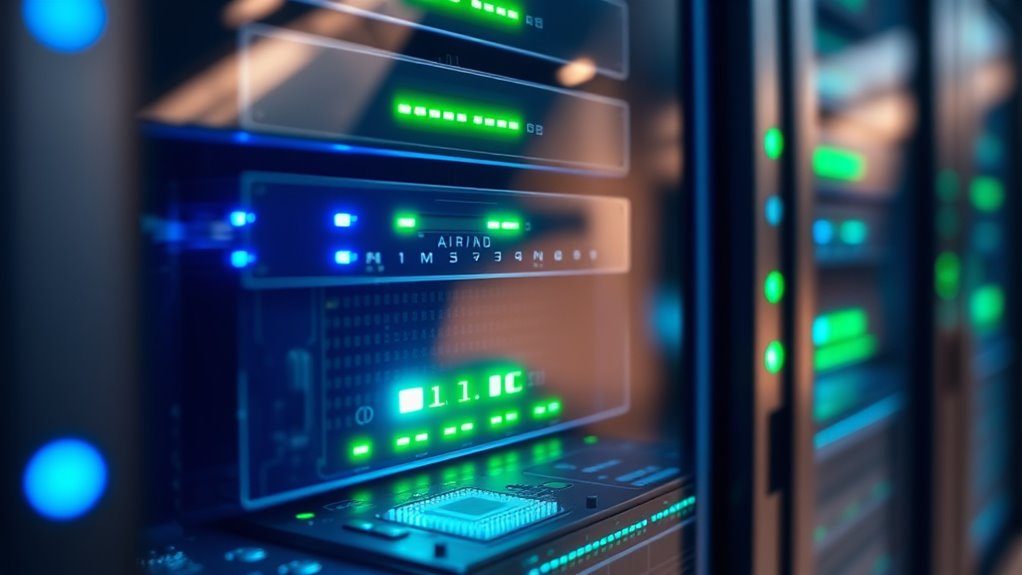Trusted Execution Environments (TEEs) play a vital role in protecting AI workloads by isolating sensitive data and algorithms from external threats. Technologies like Intel SGX create secure enclaves for tamper-proof computations, while AMD SEV encrypts entire virtual machines, adding scalability. Emerging solutions are combining hardware and cryptography to improve security, size, and performance. If you want to explore how these advancements guarantee your AI remains confidential and secure, there’s more to discover ahead.
Key Takeaways
- TEEs like SGX and SEV protect AI data and computations by isolating and encrypting sensitive processes from external threats.
- Intel SGX offers secure enclaves for confidential AI workloads but has size limitations and known vulnerabilities.
- AMD SEV encrypts entire virtual machines, enabling scalable, secure AI processing in cloud environments.
- Emerging TEEs combine hardware and cryptographic techniques to enhance security, enclave size, and resistance to side-channel attacks.
- Understanding TEEs is crucial for deploying trustworthy, privacy-preserving AI systems that maintain data confidentiality and integrity.

As artificial intelligence becomes more integrated into our daily lives, guaranteeing the security and integrity of AI computations is vital. You need to protect sensitive data and prevent malicious actors from tampering with AI models during processing. Trusted Execution Environments (TEEs) provide a secure enclave where data and computations remain isolated from the rest of the system. These environments act as a shield, safeguarding your AI workloads from external threats and potential vulnerabilities.
One of the most well-known TEEs is Intel’s Software Guard Extensions (SGX). If you’re using SGX, you can create secure enclaves that encrypt data and code during execution. This means even if the operating system or other applications are compromised, your AI computations within SGX enclaves stay protected. SGX is particularly useful for scenarios where confidentiality is paramount, such as handling private user data or proprietary algorithms. However, SGX has limitations, including restricted enclave size and some vulnerabilities that have been discovered over time. Despite this, it remains a prominent choice for secure AI processing.
Intel SGX enables secure enclaves for confidential AI computation despite potential system compromises.
Another major player is AMD’s Secure Encrypted Virtualization (SEV). Unlike SGX, which creates isolated enclaves within a system, SEV encrypts entire virtual machines. This approach allows you to run your AI workloads in a VM that’s encrypted from the hypervisor and host system. With SEV, you gain a robust layer of security, especially in cloud environments, where multi-tenant setups are common. It ensures that even if the cloud provider’s infrastructure is compromised, your data and computations stay encrypted and protected. SEV is gaining popularity for its scalability and ease of deployment in large-scale, cloud-based AI applications.
Beyond SGX and SEV, emerging TEEs and security mechanisms are continuously evolving to meet the demands of increasingly sophisticated AI workloads. Some solutions focus on hybrid approaches, combining hardware-based TEEs with cryptographic techniques to enhance security. Others explore novel architectures that improve enclave size, performance, and resilience against side-channel attacks. As AI models grow more complex and data privacy becomes a top priority, the landscape of trusted execution environments will likely expand, offering more robust options tailored to diverse deployment scenarios.
In your efforts to deploy AI securely, understanding these TEEs and their capabilities is essential. They not only help protect sensitive data during processing but also build trust in AI systems by ensuring computations remain confidential and tamper-proof. As threats evolve, staying informed about advancements in trusted execution environments will be key to maintaining the integrity of your AI applications. Additionally, research into trusted hardware architectures continues to improve the resilience and scalability of TEEs for future AI deployments.
Frequently Asked Questions
How Do TEES Impact AI Model Performance and Latency?
TEEs can introduce some latency and impact AI model performance because they add extra layers of security processing. When you run AI models inside these environments, encryption, decryption, and secure context switching take time, which can slow down inference and training. However, they help protect sensitive data, so if security outweighs speed concerns, the trade-off is often worth it. You might need optimization to minimize performance impacts.
What Are the Security Limitations of Current TEES?
Like a fragile glass sculpture, current TEEs have security limitations you should beware of. They mainly protect against software attacks but can still be vulnerable to side-channel attacks, hardware bugs, or physical tampering. Additionally, their cryptographic safeguards may not cover all attack vectors, and vulnerabilities in firmware or hardware could expose sensitive data. So, while they boost security, they aren’t foolproof and require continuous updates and layered protections.
Can TEES Support Distributed AI Workloads Effectively?
You can use TEEs to support distributed AI workloads, but they face challenges like limited scalability and performance overhead. TEEs provide secure enclaves for sensitive data and computations, yet their hardware constraints can hinder large-scale or real-time AI tasks. To effectively support distributed AI, you’ll need to combine TEEs with other security measures and optimize workload distribution, ensuring both security and efficiency are maintained across multiple nodes.
How Do TEES Integrate With Existing AI Development Tools?
Think of TEEs as secure vaults in your AI toolbox. They seamlessly integrate with existing tools by offering specialized APIs and SDKs that act like keys, unlocking protected environments. You embed these into your workflows, enabling your models and data to stay safe during development and deployment. This integration feels natural, like adding a lock to your favorite toolkit, ensuring your AI projects stay private without disrupting your usual processes.
What Are Future Trends in TEE Technology for AI?
You’ll see TEE technology becoming more seamless and scalable for AI applications, with stronger hardware security features and easier integration into existing tools. Future trends include enhanced performance through hardware acceleration, increased support for diverse AI workloads, and better developer interfaces. These advancements will guarantee your AI data remains protected without sacrificing speed or usability, enabling you to deploy secure AI solutions more confidently across various industries.
Conclusion
As you explore trusted execution environments like SGX and SEV, remember that “a chain is only as strong as its weakest link.” These technologies are evolving to better protect your AI data and processes, but they’re not foolproof yet. Stay informed and cautious, because security is an ongoing journey. Embrace these advancements, but always keep in mind that safeguarding AI requires vigilance, resilience, and a proactive mindset to stay one step ahead of threats.








